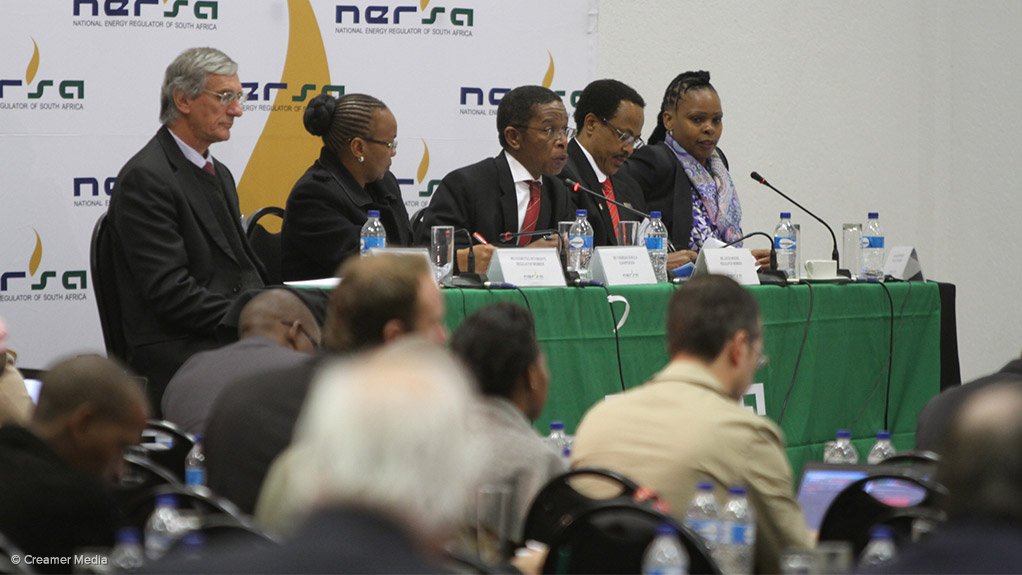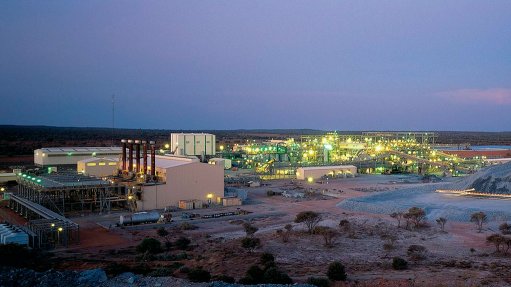Tariff timetable misalignment may see Eskom’s financial woes becoming a municipal problem


From left: Dr Rod Crompton, Khomotso Mthimunye, Thembani Bukula, Jacob Modise and Nomfundo Maseti
Photo by Duane Daws
A National Treasury circular informing municipalities that any additional bulk electricity price increases approved by the National Energy Regulator of South Africa (Nersa) after May 15 would need to be “deferred” to the 2016/17 financial year emerged as a key point of contention at hearings convened on Tuesday to deliberate on Eskom’s ‘selective reopener’ tariff application.
In a sometimes tense engagement with the five Nersa panelists, acting Eskom CEO Brian Molefe flatly denied that he had received the circular, but asserted that it should still not prevent the regulator from making a determination, as the authority on the implementation timeframe lay with Finance Minister Nhlanhla Nene, not the regulator, whose role was to determine whether the increases themselves were justified.
Through its application, the embattled State-owned utility was seeking an additional R10.9-billion for diesel to operate its Ankerlig and Gourikwa open-cycle gas-turbines, in the Western Cape, for the final three years of the five-year third multiyear price determination (MYPD3), which runs until March 31, 2018. It was also seeking R5.3-billion to cover the cost of its short-term power purchase programme (STPPP).
The net effect of the application – should an environmental levy proposed, but not yet Gazetted by the National Treasury, also be included – would be a 2015/16 tariff increase of 25.3%, instead of the 12.7% already sanctioned and implemented for direct Eskom customers from April 1, 2015. Municipalities would implement a 14% increase from July 1, with the difference attributable to the fact the municipalities would recoup the increase over nine rather than 12 months.
Molefe argued that the cash “advance” for diesel and the STPPP contracts was justifiable on the basis that it would enable Eskom to reduce the risk of load-shedding, which was having a negative impact on the economy. He argued that operating the OCGTs at a cost of R2.30/kWh was far cheaper than the economic cost of unserved electricity, which had been estimated independently as being higher than R15/kWh.
The prevailing tariff was “removed” from the current reality confronting the utility, which had no other immediate supply-side mechanisms available to it to reduce the ever-present risk of daily load-shedding. The alternatives of power ships and the conversion of the plants to run on gas rather than diesel were described as being too costly, or involving extensive conversion periods.
The use of the OCGTs, which were able to supply over 2 400 MW at short notice, had already halved the amount of load-shedding that would otherwise have taken place in April, and Eskom intended to continue to deploy them outside of peak periods to stabilise the system.
The argument was summarised by one panellist as a suggestion that South Africans pay more for fewer disruptions, or face more disruption and pay less.
South Africa had been experiencing frequent load-shedding episodes since November last year, when the Majuba coal silo collapsed. In May there were 25 consecutive days of load-shedding and the pattern, while disrupted in early June, had since re-established itself, despite Molefe announcing a new operational strategy designed to continue with maintenance with “no or minimal load-shedding”.
But more than one of the five Nersa panel members – including Thembani Bukula, Jacob Modise, Khomotso Mthimunye, Nomfundo Maseti and Dr Rod Crompton – questioned why, given the limitation imposed by the National Treasury’s circular, Eskom had persisted with a selective reopener, rather than approaching it with a full reopener that would be more fully aligned with the timeframes outlined by the Finance Minister.
Several presenters made a similar point, with the City of Cape Town’s deputy executive mayor Alderman Ian Neilson stressing that there was no legal mechanism available to municipalities to alter power tariffs approved for the 2015/16 financial year mid-stream.
Institute of Municipal Finance Officers’ Louise Muller added that, while municipalities in financial distress had the authority in the past to adjust tariffs during a financial year, the clause had since been removed from the Municipal Public Finance Management Act. Therefore, faced with the financial burden associated with an unexpected further increase in bulk tariffs, a number of municipalities would be forced to reduce other expenses, which could place further strain on service delivery.
The South African Local Government Association’s Nhlanhla Ngidi added that, should Nersa approve further increases on June 29 as outlined, municipalities would be forced to “absorb” the increases, which would place their sustainability at risk. He argued further that the application was not reasonable, affordable, or viable and lacked the basic technical information required for thorough analysis.
Neilson said the effect of further increases would be to shift Eskom’s financial problems to local governments, with the City of Cape Town estimating a potential financial impact for 2015/16 of R700-million.
Energy analyst and commentator Chris Yelland, Neilson and Muller argued that Eskom’s selective reopener be rejected in favour of a full reopener, which included more information and also took account of cost savings associated with the fact that the Medupi, Kusile and Ingula power stations were not yet operating as forecast.
EXPLORE PRIVATISATION
There was also a strong appeal for Eskom and its shareholder, the South African government, to interrogate alternative funding mechanisms besides tariffs increases, including privatisation and the raising of additional debt.
Molefe argued against the sale of equity in the company, arguing that investors would be entering the business at a time when they would experience relatively little downside, but all of the upside that would arise in about three years when Medupi, Kusile and Ingula would be delivering capacity ahead of demand and help turn Eskom cash positive.
But Molefe said that, once approved, the R23-billion injection from government, together with the conversion of the R60-billion subordinated loan into equity, would lower its gearing from 75% currently to around 69%.
Despite its current junk credit rating, Eskom believed this strengthening of Eskom’s balance sheet would enable it to approach local and international lenders, indicating that it would also seek to tap non-traditional international markets, particularly in Asia.
Notwithstanding its recent downgrade to junk status, Eskom was still planning to raise over R60-billion in debt funding during 2015/16 to cover operational and capital expenditure shortfalls that will arise even after government equity injections.
Eskom was planning to borrow R55-billion on the domestic and international capital markets, implement a R10-billion private placement and raise R1-billion from other sources.
Comments
Press Office
Announcements
What's On
Subscribe to improve your user experience...
Option 1 (equivalent of R125 a month):
Receive a weekly copy of Creamer Media's Engineering News & Mining Weekly magazine
(print copy for those in South Africa and e-magazine for those outside of South Africa)
Receive daily email newsletters
Access to full search results
Access archive of magazine back copies
Access to Projects in Progress
Access to ONE Research Report of your choice in PDF format
Option 2 (equivalent of R375 a month):
All benefits from Option 1
PLUS
Access to Creamer Media's Research Channel Africa for ALL Research Reports, in PDF format, on various industrial and mining sectors
including Electricity; Water; Energy Transition; Hydrogen; Roads, Rail and Ports; Coal; Gold; Platinum; Battery Metals; etc.
Already a subscriber?
Forgotten your password?
Receive weekly copy of Creamer Media's Engineering News & Mining Weekly magazine (print copy for those in South Africa and e-magazine for those outside of South Africa)
➕
Recieve daily email newsletters
➕
Access to full search results
➕
Access archive of magazine back copies
➕
Access to Projects in Progress
➕
Access to ONE Research Report of your choice in PDF format
RESEARCH CHANNEL AFRICA
R4500 (equivalent of R375 a month)
SUBSCRIBEAll benefits from Option 1
➕
Access to Creamer Media's Research Channel Africa for ALL Research Reports on various industrial and mining sectors, in PDF format, including on:
Electricity
➕
Water
➕
Energy Transition
➕
Hydrogen
➕
Roads, Rail and Ports
➕
Coal
➕
Gold
➕
Platinum
➕
Battery Metals
➕
etc.
Receive all benefits from Option 1 or Option 2 delivered to numerous people at your company
➕
Multiple User names and Passwords for simultaneous log-ins
➕
Intranet integration access to all in your organisation


















